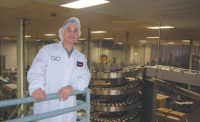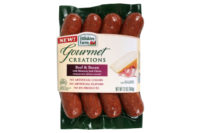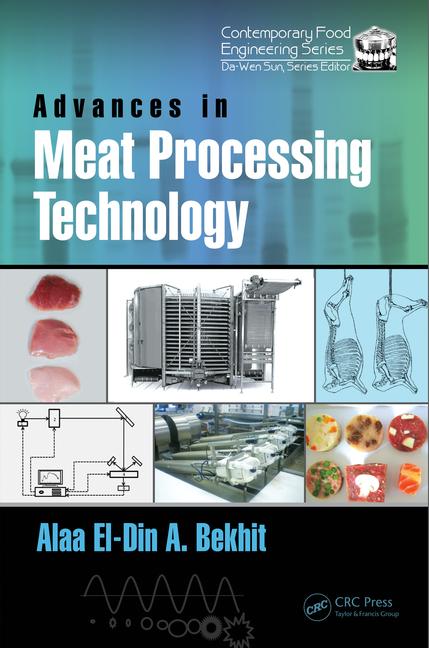Hand-Picked and High-End
By Sam Gazdziak, Senior Editor
Whether consumers are dining out or eating in, Allen Brothers provides them with quality steaks.
Thanks to Allen Brothers, anybody in the country who wants first-class, prime steaks can now get them. Even if they don’t live within close proximity to a prime steakhouse, they can have a box of steaks delivered right to their front door.
Allen Brothers has successfully taken its strong reputation as a top supplier of prime steaks to the country’s leading steakhouses and carried that success over to the catalog and online markets. Each year, more than 100,000 customers from all 50 states order the company’s steaks and other gourmet items each year, to the point that about half of Allen Brothers’ yearly revenue (in excess of $100 million) comes from catalog and Web site orders.
Allen Brothers has been around for 112 years, and the Hatoff family has run it since the early 1980s. The catalog/Web business started up in 1991, when Todd Hatoff, president of the company since 2003, joined it on what he thought would be a temporary basis. “I wanted to be more of an academic,” he explains. “I stuck around and promised for a year or two to get the retail division going, and here I am still.”
Hatoff’s family has a long history in the meat-processing industry. His great-grandfather, Jack, ran a company called Queen’s, and his grandfather, Lloyd, ran United American Meat Processors. His father, Bobby, was brought to Allen Brothers by Mel Solomon, whose uncle bought the company from the original Allen brothers shortly after the company started. Bobby Hatoff was an early proponent of portion control and ran the company to cater to the high-end foodservice market. “My father took the high road — only the best, in product and service,” Todd Hatoff explains.
There always had been a small retail part of the business, even when Hatoff’s father took over the operation. However, his expertise was in the foodservice industry, and attempts to increase the retail side of the company were slow to start. When Todd Hatoff came aboard, he put the majority of his time into getting it off the ground. To do so, he started what he calls the unique selling proposition (USP).
“We went to our prime steakhouses and asked if they wanted to be a part of this marketing campaign, and many did, more than I expected,” he says. “We put them into our marketing campaign — logos, names, quotes — to add credibility into the marketplace.”
Allen Brothers then launched a strong direct mailing and marketing campaign, telling customers if they enjoyed the quality of steaks from some of the nation’s top steakhouses, such as Morton’s of Chicago, they could now get those steaks in their home.
At the time the company began its marketing and online efforts, the Web hadn’t grown to be as all-encompassing as it is now, and Allen Brothers faced less competition.
“It still is a strong USP, but now everybody does it, and they have watered it down to where it is much weaker,” Hatoff points out, adding that the competition comes from both national companies and local butcher stores that can only ship product in-state because of U.S. Agriculture Department regulations.
Hatoff adds that customers have become smarter about their meat products and less trustworthy about claims that companies make. He has surveyed the American public several times to see if they knew the difference between choice and prime cuts. When he first started, only five percent understood. As of the last survey from two years ago, almost half of the respondents did.
“The nation is very knowledgeable about this and less trustworthy about claims that all sorts of companies are making across the country,” he explains. “There’s very limited prime [available] and a lot of places that claim it, and it’s just not the truth. They do trust Allen Brothers, but not everyone else.”
Getting started in the mail-order business is a difficult venture, especially when a newcomer has to do prospecting to create a customer database.
“It’s a highly costly field. You do not make money; you lose. You’ve got to be willing to lose money for a lot of years,” Hatoff says. “You’ve got to stick it out, and a lot of companies just cannot do that.
“It took years [for the venture to become profitable], and it would be worse today,” he continues. “I pity the soul who attempts to enter the mail-order business today, because of the costs. It would be 10 or 20 times worse than it was when I started out, because paper, postage and the Web are such expensive commodities.”
Hatoff credits the company’s aggressive marketing for the success of the catalog and Web site. Allen Brothers has also gotten positive endorsements from numerous radio personalities, along with its radio advertisements. “There is not a square foot of land in the United States that is not covered by radio for Allen Brothers,” he notes.
Prime, and then some
Allen Brothers’ foodservice clients include prime restaurant chains, such as Morton’s, Del Frisco’s and N9NE Steakhouse, as well as independent restaurants including Nick & Sam’s and Al Biernat’s of Dallas, Delmonico’s Steak House in Philadelphia and Chicago’s Gene & Georgetti’s and Chicago Chop House. Hatoff says the company covers virtually every major U.S. city with its products.
He says that the prime steakhouse sector has been performing very well, and Allen Brothers has grown along with the restaurants.
“I know the industry has had its ups and downs, but for us it’s been very, very strong,” he explains. He attributes that success to the quality that those types of restaurants offer. “Once you go to a Morton’s or a Del Frisco’s, it’s hard to go anywhere else. When you eat great prime like you can get at those restaurants, that’s properly aged and honestly delivered, the public becomes very wise, very quickly.”
One of the things that has ensured Allen Brothers’ success in the steak business is the care with which it chooses its products. It only uses meat that the USDA has certified as prime.
“But even that’s not enough for us, so when we bring in all the prime that we can from the big players and the smaller operators, we hand-select everything,” Hatoff points out. Marbling, silkiness, color, fat and any imperfections are all considered before the meat is accepted. The company also uses several types of wet-aging and dry-aging to bring out the best in the beef, contrary to the belief that there is only one way to wet-age and dry-age beef. “It’s not as simple as the whole country and the rest of the industry thinks it is,” he says.
The catalog began at 16 pages and has now jumped to 60 pages, covering a wide range of products beyond steaks. Certainly, Allen Brothers’ filet mignons, porterhouses, ribeyes and other cuts are among the standout items, but there are seafood, poultry, pork, lamb and veal entrees, as well as appetizers and desserts. The items are expensive — an order of four 12-ounce dry-aged strip steaks costs $159.95, for example — but keep with the company’s reputation for quality. Every product in the company’s catalog has a strict set of specifications, and anyone on the production line can pull a product if he or she doesn’t think the meat matches those specifications.
There is also a heat-and-serve section, containing dishes like chicken pot pie and braised veal osso buco. Allen Brothers also will be launching a partnership with a renowned celebrity chef at the end of March on a series of value-added products.
For those who are looking for a different kind of steak offering, Allen Brothers also offers selected Kobe-style Wagyu steaks. Hatoff says the company is exploring other “niche” areas, like natural meats.
“We have all-natural lamb, veal and beef products,” he says. “We are still testing natural prime. That is going to be coming, but it’s been quite the process to get there. Organic, I don’t think, is ever going to fit in at Allen Brothers, because I haven’t seen any organic beef that grades prime.”
The company’s accomplishments in the foodservice and catalog/Web markets have spurred the company to greater heights. Its USP and recommendations from its restaurant partners continue to attract catalog customers, and the prevalence of its catalog and advertising has led to many restaurants approaching the company for business.
The company is in the planning stages of a major expansion. Currently, there are two processing facilities and two holding facilities, all located in the Chicago area. Combined, the facilities total more than 100,000 square feet in size. Hatoff plans to either add a new fulfillment center to one of the existing buildings or to build an entirely new operation. “We’re starting now,” he says, “and we’re weighing everything and talking with our consultants, figuring out what’s going to be the best for us to do.
“We’re experiencing rapid growth right now,” he adds.








